|
Southwestern American Indian Bracelets: The Choicest Collectible
By Paula A. Baxter
Posted May 2016

The American Indian jewelry marketplace has a wonderfully diverse selection of adornment, but the cuff bracelet has always had the greatest appeal to collectors. When we examine why these wristlets have proved to be enduringly popular, several factors come into focus. In addition, there are a number of special considerations that face the would-be collector.
|
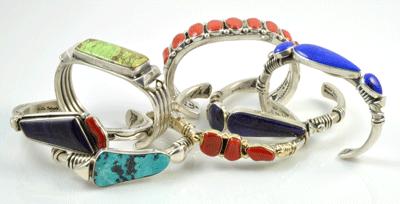
|
A decade of bracelet designs by Orville Tsinnie, Navajo, 2002–2012.
|
The two tribes in North American with the largest, most active market for jewelry are the Navajo and Pueblo peoples of the U.S. Southwest. The Navajo occupy the largest reservation in the country, spread over three states and roughly the size of Rhode Island. The twenty-seven Pueblos occupy the central Rio Grande and western valleys of New Mexico and a remote section of northeastern Arizona. The cities with the most galleries and stores for Indian jewelry are Albuquerque, Santa Fe, Taos and Gallup in New Mexico, and Flagstaff, Phoenix and Tucson in Arizona. Every year, large Indian Markets are held in Phoenix and Santa Fe that draw thousands of buyers who enjoy purchasing directly from Native artists who come from all over the continent.
There also exists an equally thriving market for antique historical Southwestern Indian jewelry (1870s to 1930s) and vintage adornment (1940s–1980). If these dates seem rather recent compared to other categories of collectibles, this has to do with the history of the Navajo and Pueblo who did not begin making metalwork until after the Civil War. The earliest examples of copper, brass, and silver bracelets can be dated to the 1870s, and they began setting turquoise, coral, jet, and other semiprecious stones in silver by the 1880s. Historical era jewelry, especially bracelets, command high prices largely because of the rarity of these items—particularly since many pieces were either melted down to make newer works or buried with their owners. Nineteenth-century Indian bracelets tend to be either all silver with geometrical stamp work or silver cuffs set with one or more pieces of stonework (usually turquoise), of surprisingly high quality given the rough tools of that time.
|
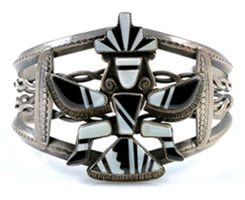
|
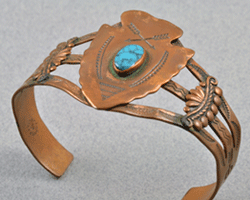
|
|
Vintage Zuni black and white Knifewing bracelet, 1940s-1950s.
|
Copper arrowhead bracelet done in the style
of Fred Harvey tourist era.
|
The first phase of American tourism in the West began in the early 1900s with the Fred Harvey Company’s domination of transcontinental railway travel services. The second era, tourism by car, began in the late 1920s with the opening of Route 66. In both periods, outsiders flooded New Mexico and Arizona. Curio silver bracelets became a popular collectible because they were lightweight, attractively exotic in design, and very portable. Tourists also stopped at a trading post on the Navajo reservation or in a reservation border town like Gallup to purchase a piece they knew had been made for and/or worn by an Indian.
Indian traders were Anglo businessmen (and a few women) who established a trade system with the Indians in the early-to-mid twentieth century. Indian smiths were making larger quantities of jewelry for sale to themselves and the general marketplace. Already, the stereotypical Indian bracelet was a solid silver cuff stamped with various geometrical or organic design motifs and set with turquoise. Various Native cultures became known for their stylistic renditions: the Hopi developed fine overlay work, the Zunis produced delicate lapidary work on silver, often using multiple small stones, and Navajo cuffs might be narrow bands of engraved and stamped silver or larger pieces with finely shaped stones in handmade bezels.
|
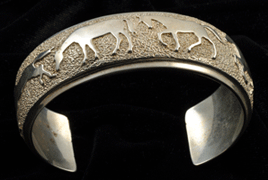
|
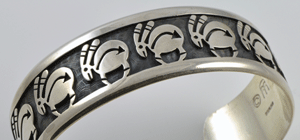
|
|
Silver overlay horses design by
Ben Nighthorse Campbell, c. 2000.
|
Hopi overlay bracelet with rabbit design
by Bueford and Dina Dawahoya, c. 1990.
|
More than any other existing jewelry form, Southwestern Indian-made bracelets are immediately recognized as cuff-shaped. While Indian artists do create soldered round bangles or link bracelets on occasion, those who look for a real Indian bracelet expect a cuff. The Indian bracelet encircles the wrist—but not completely. Newcomers, if they are lucky, are shown how to put on such a bracelet. The cuff is placed against the inside center of a wrist at an angle, and then rolled over the bone at the side of the wrist.
The bracelet should fit firmly and comfortably. It must lie anchored on the wrist and cannot be shaken out of place. If the circumference of the bracelet shank is too tight or too loose, the wearer feels this imbalance at once. You cannot squeeze yourself into a bracelet that’s too small, even though you might do this with shoes or clothing. A bracelet cuff that fits too loosely is ungainly and may fall off. Most wearers expect their cuff to fit in a manner that makes the bracelet a flattering frame for their wrist. For those who like more of a good thing, cuffs can easily be stacked along the forearm.
|
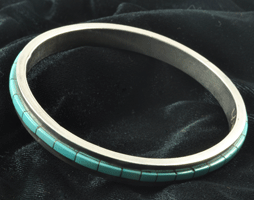
|
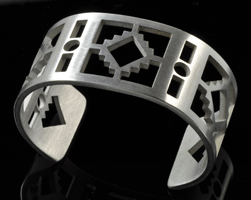
|
|
Turquoise and silver bangle
by Terry Leonard, Zuni, c. 1995.
|
Stainless steel modern cuff design by Carlton Jamon, Zuni, 2014.
|
From the beginning, Native smiths crafted cuffs in masculine, feminine, and child-sized proportions. They produced cuffs according to demand. Even when the curio trade started up with non-Native purchasers in mind, cuffs were made in a range of sizes. Jewelry creators understood that pieces should correspond to various body types. Historical evidence shows that Indian men and women wanted and wore some bracelets for everyday activities and held back others for ceremonial and social occasions. Among the Navajo, bracelets along with other metal adornment became known as “hard goods.” They were a yardstick to an individual’s material wealth and standing. Jewelry could be pawned or held as collateral until needed for a specific purpose.
Once traders and commercial middlemen became involved in the Indian jewelry industry, they meddled with the design and creation process. They altered design motifs to what they thought non-Natives would want. One of the largest changes involved making the bracelet (along with other jewelry forms) more lightweight. Non-Natives worried that bracelets made for Native consumption would be thought to be too heavy for regular wear. European American jewelry was generally lightweight; therefore, Indian pieces should be too. While some tourists became collectors who preferred the feeling of heavier metal pieces, the curio trade embraced bracelets made from sheet silver once it became available.
Over the years, some American Indian jewelers have retained the notion that bracelets for commercial sale shouldn’t be massive or heavy. Many Zuni jewelers produce lightweight pieces as a matter of course. Other creators feel that cuffs should retain some modicum of heft. The solidity of Southwestern Indian bracelets is a characteristic, but not a given, of that essential cuff. Many dealers and collectors particularly cherish the concept of a sculptural bracelet.
|

|
Beaded bracelet with dragonfly design
by Kiowa artist Teri Greeves, c. 2005.
|
In addition, bracelets made by non-Natives living in the American Southwest espouse the cuff shape as one of their product characteristics. Such pieces go by the label “Southwestern Style.” Sometimes consumers new to collecting become confused by this distinction. Southwestern Style jewelry can and does resemble Native-made work; those in the know in the marketplace, however, recognize that this term means the pieces are usually not Indian-made but do reflect Native design elements. Looked at in a certain way, this is a compliment to Native ingenuity, since imitation has always been a genuine form of flattery.
-----------------------------------------
Southwestern Indian Bracelets: The Essential Cuff
by Paula A. Baxter / Photography by Barry Katzen
This design history of Southwestern Indian bracelets examines their start in 1868 up through 1970, and the post-1980 legacy that honors those first 100 years. More than 360 color photos illustrate the history. The book begins by examining sources for designs and how styles came into being, followed by a look at historic, vintage, curio, and post-1980 bracelets that reflect the new Native Style.
Learn how Native Americans have always made essential contributions to design by tracking ongoing craft innovation and social change and how popular culture impacts the individual artists who create this jewelry form. Whether featured on eBay, sold on QVC’s home shopping channel, or seen in the pages of O, The Oprah Magazine, old and new Southwestern Indian cuff bracelets are an integral part of today’s finest jewelry-making.
ISBN 978-0764348686, Schiffer Publishing Ltd., $39.99, 176 pages.
|